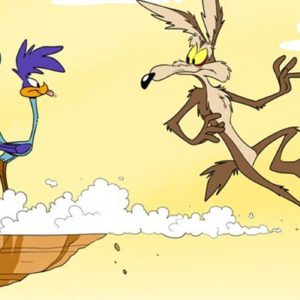When reading Tom Gunning’s chapter, I found her argument on the influence of the Lumiere Brothers’ film L’Arroseur arrosé (Lumiere, Paris, 1865), on narrative comedy particularly interesting. It made me think of more recent comedy shorts that follow the conventions of the “Mischief Gag”(Gunning 89) that the 1865 film introduces, and made me specifically think of Warner Brothers RoadRunner and Wile E Coyote animated series. Specifically looking at how the core tenets of comic film in L’Arroseur arrose are seen in these shorts, proving the films’ influence is still prominent today.
Gunning highlights that the 1865 film was especially influential to its genre because of what followed. The film had many firsts, but more importantly, it set the tone and standards for many films to follow. Many of the Looney Tune cartoons do utilize the mischief gag in that it follows the two phases of action that Gunning addresses. (The set-up of the joke and then the action being undertaken). But, the reason that the Roadrunner and the Coyote stood out to me was first because of the characters’ dynamic. These characters perfectly fit into the trope of the “Rascal” and “Victim” that Gunning introduces, with Roadrunner being the rascal and Coyote being the victim. Throughout the animated series, we see multiple attempts by the coyote to catch the Roadrunner while he easily flees, and the coyote ends up being the victim of his own traps and is tormented further by the Roadrunner.
especially influential to its genre because of what followed. The film had many firsts, but more importantly, it set the tone and standards for many films to follow. Many of the Looney Tune cartoons do utilize the mischief gag in that it follows the two phases of action that Gunning addresses. (The set-up of the joke and then the action being undertaken). But, the reason that the Roadrunner and the Coyote stood out to me was first because of the characters’ dynamic. These characters perfectly fit into the trope of the “Rascal” and “Victim” that Gunning introduces, with Roadrunner being the rascal and Coyote being the victim. Throughout the animated series, we see multiple attempts by the coyote to catch the Roadrunner while he easily flees, and the coyote ends up being the victim of his own traps and is tormented further by the Roadrunner.
This clip is the perfect example of this dynamic, wherein the first two minutes, the Coyote puts a rock in the Roadrunner’s path, but he simply runs through it. Coyote gets stuck inside the rock, and then is “washed away” by the Roadrunner, and then proceeds to get hit by a car! While there is slightly more to these characters than the one suggested by GunningI think it follows the same dynamic. I thought that it was very interesting that a very popular 21st-century cartoon skit, and a childhood favorite of many, follows the tropes introduced in L’Arroseur arrose. It also justifies Gunning’s argument of the influence of the Lumiere Brothers’ film on the current-day media.
Tom Gunning, “Crazy Machines in the Garden of Forking Paths,” Classical Hollywood Comedy, ed.
Karnick and Jenkins (Los Angeles: AFI/Routledge, 1995), 87-105, 360-363.
The Roadrunner and the Coyote- New Episodes from the Looney Tunes Cartoons (2021). Warner Bros Inc. Youtube. https://www.youtube.com/watch?v=gi5Hm2MfyjU
I found the correlation you made between Tom Gunning’s chapter and Wile E Coyote and the Road Runner very interesting: just like early films, these characters perfectly depict the “rascal” and “victim” dynamic.
I also honestly think it is curious how these Looney Tunes episodes always portray the same structure where Will E Coyote tries to catch the Road Runner but always ends up failing and gets hurt most of the times. It is almost like we, as an audience, do not want the Road Runner to get caught because we kind of want to see what traps Will E Coyote will think of to finally capture it.
This got me thinking about other Looney Tunes, and I think this setup is truly their bread and butter. Virtually every older Bugs Bunny cartoon I can think of also follows this format, whether it be him vs. Elmer Fudd or him vs. Daffy Duck vs. Elmer Fudd. However, I think they’ve definitely grown apart from this format in recent years and it seems to be almost nonexistent in this particular IP. It may be interesting to look at popular cartoons now and see if there are traces of the mischief gag still present today.